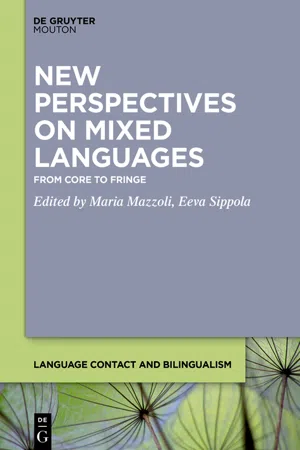
New Perspectives on Mixed Languages
From Core to Fringe
- 416 pages
- English
- ePUB (mobile friendly)
- Available on iOS & Android
New Perspectives on Mixed Languages
From Core to Fringe
About This Book
A growing number of language varieties with diverse backgrounds and structural typologies have been identified as mixed. However, the debate on the status of many varieties and even on the existence of the category of "mixed languages" continues still today.
This volume examines the current state of the theoretical and empirical debate on mixed languages and presents new advances from a diverse set of mixed language varieties. These cover well-known mixed languages, such as Media Lengua, Michif, Gurindji Kriol, and Kallawaya, and varieties whose classification is still debated, such as Reo Rapa, Kumzari, Jopará, and Wutun. The contributions deal with different aspects of mixed languages, including descriptive approaches to their current status and origins, theoretical discussions on the language contact processes in them, and analysis of different types of language mixing practices.
This book contributes to the current debate on the existence of the mixed language category, shedding more light onto this fascinating group of languages and the contact processes that shape them.
Frequently asked questions
Information
Wutun as a mixed language
1 Introduction
1.1 The Wutun language and the Amdo Sprachbund
Table of contents
- Title Page
- Copyright
- Contents
- Dedication
- Mixed languages: From core to fringe
- Noun-Verb mixed languages: Similarities and differences
- Advances in mixed language phonology: An overview of three case studies
- How sentence processing sheds light on mixed language creation
- Michif mixed verbs: Typologically unusual word-internal mixing
- VO vs. OV: What conditions word order variation in Media Lengua?
- Linguistic manipulations in Kallawaya
- Social identity and the formation and development of Barranquenho
- Ilokano-Spanish: Borrowing, code-switching or a mixed language?
- Jopara as a case of a variable mixed language
- Pronominal usage in Cité Duits, a Dutch-German-Limburgish contact variety
- Wutun as a mixed language
- Repertoire management and the performative origin of Mixed Languages
- Subject Index
- Language Index